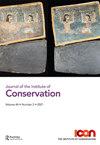Initial investigation into the effect of varying parameters in using an Er:YAG laser for the removal of brass-based overpaint from an oil-gilded frame
IF 1
0 HUMANITIES, MULTIDISCIPLINARY
引用次数: 3
Abstract
Abstract The removal of brass-based overpaint, applied during previous restoration, from an oil-gilded frame by the application of solvents can be challenging and difficult to control due to the often similar solubilities of the paint and oil gilding. In this study, Er:YAG laser radiation (2940nm) has been used to remove brass-based overpaint from a discoloured overpainted oil-gilded frame. Tests have been systematically carried out to investigate the effect of changes to: (1) laser parameters (fluence; number of pulses; pulse duration; repetition rate), and (2) choice of pre-wetting agent (water; isopropyl alcohol; acetone) on the removal process. Observations of the irradiated surfaces revealed that the thermal interaction between laser radiation and the overpaint led to decomposition of the overpaint binder which weakened the paint sufficiently to enable removal using a cotton swab. By using acetone as a pre-wetting agent, the overpaint was removed from a small area of the frame by 20 pulses at 0.8J/cm2 (80µs pulse duration; 1Hz) revealing the gold leaf. This investigation demonstrates the potential for Er:YAG laser radiation in the controlled removal of brass-based overpaint from gilded wood and the requirement for further work to optimise the removal process and characterise the ‘cleaned’ surface.用Er:YAG激光器去除油镀金框架黄铜基外涂层时不同参数影响的初步研究
由于油漆和镀金的溶解度通常相似,在以前的修复过程中,通过应用溶剂从油镀金框架上去除黄铜基复漆是具有挑战性和难以控制的。在这项研究中,Er:YAG激光辐射(2940nm)被用于去除褪色的覆漆油镀金框架上的黄铜基覆漆。系统地进行了试验,以研究以下变化的影响:(1)激光参数(通量;脉冲数;脉冲持续时间;(2)预湿润剂(水;异丙醇;丙酮)在去除过程中。对辐照表面的观察表明,激光辐射与复涂剂之间的热相互作用导致复涂剂粘合剂的分解,从而使油漆减弱到足以使用棉签去除。使用丙酮作为预润湿剂,以0.8J/cm2(80µs脉冲持续时间)的速度通过20次脉冲从框架的一小块区域去除覆盖涂料;1Hz)露出金箔。这项研究证明了Er:YAG激光辐射在控制去除镀金木材上的黄铜基复漆方面的潜力,以及进一步优化去除工艺和表征“清洁”表面的需求。
本文章由计算机程序翻译,如有差异,请以英文原文为准。
求助全文
约1分钟内获得全文
求助全文
来源期刊

Journal of the Institute of Conservation
HUMANITIES, MULTIDISCIPLINARY-
CiteScore
1.50
自引率
0.00%
发文量
22
期刊介绍:
The Journal of the Institute of Conservation is the peer reviewed publication of the Institute of Conservation (Icon). As such, its aims reflect those of Icon, to advance knowledge and education in conservation and achieve the long term preservation and conservation of moveable and immoveable cultural heritage. The Journal provides a collective identity for conservators; it promotes and supports both the profession and professionalism. With international contributions on all aspects of conservation, it is an invaluable resource for the heritage sector. The specific aims of the Journal are to: 1. promote research, knowledge and understanding of cultural heritage conservation through its history, practice and theory 2. provide an international forum to enable and disseminate advances in research, knowledge and understanding relating to conservation and heritage 3. champion and support professional standards of heritage conservation in the UK and internationally 4. provide a permanent record of issues relating to conservation and heritage 5. be financially and operationally sustainable. To achieve these aims, the Journal invites contributions from all those involved in the conservation of cultural heritage and related activities. Areas of interest include understanding cultural heritage materials and their degradation; subject reviews and histories of cultural heritage materials and conservation treatments; new, innovative or improved approaches to conservation and collections care theory, practice, communication, management and training; case studies demonstrating new, innovative or improved approaches; and conservation in its wider context. Submitters are encouraged to demonstrate how their work is of practical application to conservation. To maintain professional standards and promote academic rigour, submissions of articles and shorter notices are subject to an anonymous peer review process.
 求助内容:
求助内容: 应助结果提醒方式:
应助结果提醒方式:


